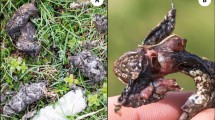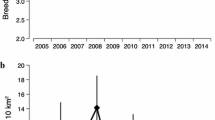Abstract
The body mass of birds is the result of a trade-off between predation and starvation risks. According to the mass-dependent predation hypothesis, birds reduce their body mass when predation risk increases. Many studies have supported this hypothesis, but it has rarely been possible to investigate the mass-dependent predation risk response by comparing individuals of the same species foraging simultaneously at the same location, in the field and facing a real (not simulated) risk of predation. Wintering Siskins (Carduelis spinus) are divided in two subpopulations: residents, which stay in a foraging area for several weeks or months, and transients, which only remain a few hours or days. In this paper, we present a natural experiment by comparing the body mass variation of resident and transient Siskins between a period of the wintering season without avian predators and another period with a Sparrowhawk (Accipiter nisus) that was hunting regularly. We found that resident Siskins reduced their body mass with the presence of the hawk, while transients did not. Since in a previous study with no avian predators at the study area it was found that the difference in body condition between residents and transients did not vary throughout the wintering season, we can confidently say that the reduction in body mass observed in this study was directly linked to the presence of the hawk. We additionally found that this reduction was not associated with the dominance of residents over transients. We discuss the advantages of residence related to the knowledge of actual predation risk. Our results strongly support the mass-dependent predation hypothesis.
Zusammenfassung
Ortsansässige, aber nicht durchziehende Erlenzeisige verringern ihre Körpermasse bei erhöhtem Prädationsrisiko: ein natürliches Experiment Die Körpermasse von Vögeln beruht auf einer Wechselbeziehung von Prädationsrisiko und der Gefahr des Hungertodes. Laut der Hypothese der masseabhängigen Prädation verringern Vögel ihre Körpermasse mit steigendem Prädationsrisiko. Diese Hypothese wird von vielen Studien gestützt, aber wurde noch nie an einem System im Feld getestet, in dem Individuen einer Art verglichen wurden, die zur gleichen Zeit am gleichen Ort nach Nahrung suchen und dabei einem echten (nicht simulierten) Prädationsrisiko ausgesetzt sind. Überwinternde Erlenzeisige (C. spinus) werden in zwei Untergruppen geteilt: ortsansässige, die mehrere Wochen oder Monate am selben Ort bleiben, und Durchzügler, die sich nur einige Stunden oder Tage am selben Ort aufhalten. In diesem Bericht präsentieren wir ein natürliches Experiment: wir verglichen die Variation in der Körpermasse ortsansässiger und durchziehender Erlenzeisige zwischen einer Periode ohne Anwesenheit von Beutegreifern und einer Periode, in der ein Sperber (A. nisus) regelmäßig dort jagte. Es zeigte sich, dass ortsansässige Erlenzeisige ihre Körpermasse verringerten als der Sperber anwesend war, die Durchzügler hingegen nicht. Da eine frühere Studie im selben Gebiet ohne Anwesenheit von Beutegreifern ergab, dass die Körpermassen der ortsansässigen und durchziehenden Erlenzeisige innerhalb der Wintersaison nicht schwankten, sind wir überzeugt, dass die hier beobachtete Verringerung der Körpermasse direkt auf die Anwesenheit des Sperbers zurückzuführen ist. Des Weiteren fanden wir keinen Zusammenhang zwischen der verringerten Körpermasse und der Dominanz der ortsansässigen gegenüber den durchziehenden Erlenzeisigen. Wir diskutieren die Ergebnisse mit Blick auf die Vorteile der Ortsansässigkeit in Bezug auf das Wissen um das bestehende Prädationsrisiko. Unsere Ergebnisse stützen die Hypothese der masseabhängigen Prädation.

Similar content being viewed by others
References
Bednekoff PA, Houston AI (1994) Optimizing fat reserves over the entire winter: a dynamic model. Oikos 71:408–415
Burns JG, Ydenberg RC (2002) The effects of wing loading and gender on the escape flights of least sandpipers (Calidris minutilla) and western sandpipers (Calidris mauri). Behav Ecol Sociobiol 52:128–136
Carrascal LM, Polo V (1999) Coal tits, Parus ater, lose weight in response to chases by predators. Anim Behav 58:281–285
Clark CW, Ekman J (1995) Dominant and subordinate fattening strategies: a dynamic game. Oikos 72:205–212
Cresswell W (1998) Diurnal and seasonal mass variation in blackbirds Turdus merula: consequences for mass-dependent predation risk. J Anim Ecol 67:78–90
Desportes JP, Gallo A, Cézilly F (1991) Effet de la familiarisation avec l’environnement sur le comportement de vigilance de la tourterelle rieuse Streptopelia risoria. Behav Proc 24:177–183
Domènech J, Senar JC (1997) Trapping methods can bias age ratio in samples of passerine populations. Bird Study 44:348–354
Ekman J (2004) Mass-dependence in the predation risk of unequal competitors; some models. Oikos 105:109–116
Gentle LK, Gosler AG (2001) Fat reserves and perceived predation risk in the great tit, Parus major. P Roy Soc B-Biol Sci 268:487–491
Gosler AG, Greenwood JJD, Perrins C (1995) Predation risk and the cost of being fat. Nature 377:621–623
Haftorn S (1989) Seasonal and diurnal body weight variations in titmice, based on analysis of individual birds. Wilson Bull 101:217–235
Hedenström A (1992) Flight performance in relation to fuel load in birds. J Theor Biol 158:535–537
Higginson AD, McNamara JM, Houston AI (2012) The starvation-predation trade-off predicts trends in body size, muscularity, and adiposity between and within taxa. Am Nat 179:338–350
Hinde RA (1956) The biological significance of the territories of birds. Ibis 98:340–369
Jakob EM, Marshall SD, Uetz GW (1996) Estimating fitness: a comparison of body condition indices. Oikos 77:61–67
Krams I, Cirule D, Suraka V, Krama T, Rantala MJ, Ramey G (2010) Fattening strategies of wintering great tits support the optimal body mass hypothesis under conditions of extremely low ambient temperature. Funct Ecol 24:172–177
Kullberg C (1998) Does diurnal variation in body mass affect take-off ability in wintering willow tits? Anim Behav 56:227–233
Kullberg C, Fransson T, Jakobsson S (1996) Impaired predator evasion in fat blackcaps (Sylvia atricapilla). P Roy Soc B-Biol Sci 263:1671–1675
Lilliendahl K (1997) The effect of predator presence on body mass in captive greenfinches. Anim Behav 53:75–81
Lima SL (1986) Predation risk and unpredictable feeding conditions: determinants of body mass in birds. Ecology 67:377–385
McLeod R, Barnett P, Clark JA, Cresswell W (2005) Body mass change strategies in blackbirds Turdus merula: the starvation-predation risk trade-off. J Anim Ecol 74:292–302
McLeod R, Lind J, Clark JA, Cresswell W (2007) Mass regulation in response to predation risk can indicate population declines. Ecol Lett 10:945–955
McNamara JM, Houston AI (1990) The value of fat reserves and the trade-off between starvation and predation. Acta Biotheor 38:37–61
Metcalfe NB, Ure SE (1995) Diurnal variation in flight performance and hence potential predation risk in small birds. P Roy Soc B-Biol Sci 261:395–400
Pascual J (2013) About eating and not being eaten: vigilance and foraging strategies in wintering Eurasian siskins (Carduelis spinus). PhD Thesis, Universitat de Barcelona
Pascual J, Senar JC, Domènech J (2014) Are the costs of site unfamiliarity compensated with vigilance? A field test in Eurasian siskins. Ethology 120:1–13
Ratikainen II, Wright J (2013) Adaptive management of body mass by Siberian jays. Anim Behav 85:427–434
Schultner J, Kitaysky AS, Welcker J, Hatch S (2013) Fat or lean: adjustment of endogenous energy stores to predictable and unpredictable changes in allostatic load. Funct Ecol 27:45–55
Senar JC, Camerino M (1998) Status signalling and the ability to recognize dominants: an experiment with siskins (Carduelis spinus). Proc R Soc Lond B 265:1515–1520
Senar JC, Copete JL, Metcalfe NB (1990) Dominance relationships between resident and transient wintering Siskins. Ornis Scand 21:129–132
Senar JC, Burton PJK, Metcalfe NB (1992) Variation in the nomadic tendency of a wintering finch Carduelis spinus and its relationship with body condition. Ornis Scand 23:63–72
Senar JC, Camerino M, Copete JL, Metcalfe NB (1993) Variation in black bib of the Eurasian Siskin (Carduelis spinus) and its role as a reliable badge of dominance. Auk 110:924–927
Svensson L (1992) Identification guide to European Passerines. L. Svensson, Stockholm
Witter MS, Cuthill IC (1993) The ecological costs of avian fat storage. Philos T R Soc Lon B 340:73–92
Witter MS, Cuthill IC, Bonser RHC (1994) Experimental investigations of mass-dependent predation risk in the european starling, Sturnus vulgaris. Anim Behav 48:201–222
Yoder JM, Marschall EA, Swanson DA (2004) The cost of dispersal: predation as a function of movement and site familiarity in ruffed grouse. Behav Ecol 15:469–476
Zimmer C, Boos M, Poulin N, Gosler A, Petit O and Robin JP (2011) Evidence of the trade-off between starvation and predation risks in ducks. Plos One 6(7):e22352
Acknowledgments
We give thanks to Jordi Domènech, David Boné, Anna Serra, Esther Vilamajó and Miquel Boix for field assistance, and to Nuria Mallén and Mª Luisa Arroyo for laboratory assistance. We would also like to thank José Domingo Rodríguez Teijeiro, Jordi Peig and Andy Green for their methodological advice, and anonymous reviewers for their critical discussions. This paper is a contribution to projects BOS 2000-0141 and CGL 2012-38262 from Ministerio de Ciencia e Innovación and Ministerio de Economía y Competitividad. We declare that the manipulations of birds that were undertaken in this study comply with the current laws of Spain.
Author information
Authors and Affiliations
Corresponding author
Additional information
Communicated by A. Hedenström.
Rights and permissions
About this article
Cite this article
Pascual, J., Senar, J.C. Resident but not transient Eurasian Siskins reduce body mass in response to increasing predation risk: a natural experiment. J Ornithol 156, 451–456 (2015). https://doi.org/10.1007/s10336-014-1143-8
Received:
Revised:
Accepted:
Published:
Issue Date:
DOI: https://doi.org/10.1007/s10336-014-1143-8




